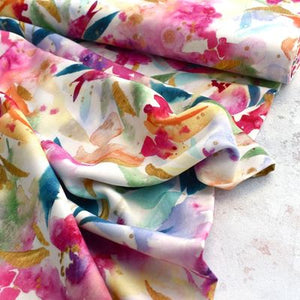You likely have a modest collection of fabrics that you are planning to sew into some gorgeous me-made garments (okay, let’s be honest, it’s likely more of a mountain than a molehill). Though it’s certainly tempting to reach for that pattern and rotary cutter right away, you should always take the time to consider the care of your fabric first.
Always Prewash!
There are a few reasons to always prewash your fabrics, two of which have to do with the word “sizing.” One type of sizing refers to a process during manufacturing where a chemical is applied to the fabric to add strength and stiffness to protect the fabric or make it easier to work with during the manufacturing process. Most people are more familiar with the other type of sizing with is concerned with how much a fabric might shrink during laundering. A good rule of thumb is to follow the old saying “Start as you mean to go on,” and always wash your fabric the same way from the beginning to avoid any unpleasant “surprise” shrinkage to your finished garments, which can cause puckering to your seams and the overall fit.
Though synthetic fabrics generally don’t shrink, another important reason to prewash is the potential for color bleeding. This is also the reason that we recommend prewashing with like colors. You may have planned to make a red dress and some white shirts, but unless you prewash separately, you may suddenly find a lot of pink in your me-made wardrobe!
Sew Smart! Serge or sew a zig-zag stitch along the edges of fabrics that fray easily before prewashing.

Care Instructions by Fabric Type
Many fabrics are made up of a blend of different types, so we suggest that you go by the type of fiber with the largest percentage OR the weakest fiber (most temperamental) when deciding how to care for it.
-
Cotton
- Wash—Any water temperature
- Dry—Dryer on high or line dry
- Iron—Steam or press on high heat
- Linen
- Wash—Any water temperature
- Dry—Dryer on low or line dry
- Iron—Press on high heat only when damp
- Polyester
- Wash—Warm water
- Dry—Dryer on low or line dry
- Iron—Steam or press on low-medium heat
- Rayon (aka Viscose)
- Wash—Cold water on delicate cycle or hand wash
- Dry—Press out water with a towel, reshape, and lay flat to dry or hang dry (Never put viscose or rayon in the dryer!)
- Iron—Steam or turn inside out and iron on medium heat while damp
- Cotton Voile & Lawn
- Wash—Cold water on delicate cycle or hand wash
- Dry—A few minutes in the dryer on low to release wrinkles, then line dry
- Iron—Use a pressing cloth and iron on low heat
- Wool
- Wash—Dry Clean. If washing at home, cold water on delicate cycle inside out or hand wash.
- Dry—Press out water with a towel, reshape and lay flat to dry or dry clean (Never put wool in the dryer!)
- Iron—Steam only
- Silk & Silk Blends (50% or more)
- Wash—Dry Clean. If washing at home, cold water on delicate cycle or hand wash
- Dry—Press out water with a towel, reshape, and lay flat to dry (Never put silk in the dryer!)
- Iron—Use a pressing cloth and steam or iron on low inside out
Sew Smart! When in doubt, always go with the cooler, gentler option for washing, drying, and ironing.

Fabric Storage
No one wants to deal with a wrinkly pile of material during their precious sewing time, and the best way to avoid that is to fold and store your fabrics properly after prewashing.
Here are some tips to help:
- Make sure to always fold promptly after removing from the dryer before wrinkles set in. Sometimes, you may also need to do a quick press on your fabric to avoid set-in creases.
- Since most pattern instructions call for cutting with selvage edges together, if you make that your first fold, it will save a step when you’re ready to start cutting out your garment.
- There are a variety of methods to fold and organize your fabric in order to both keep it in the best possible shape and keep track of your stash. Pinterest is a great additional resource to get a ton of creative ideas that might work for you!
- The most common ways to organize your fabric stash are by color, pattern, theme, fabric type, weight, etc.
- Many sewers use magazine boards or hangers to ensure that their fabrics remain neatly folded while they are storing them.
- Popular storage methods include shelving units, labeled file drawers, plastic storage containers, hanging fabrics in a closet.

Garment Storage
After you’ve spent your valuable time and money creating those gorgeous me-made garments, it only makes sense to continue to respect and care for them and make sure they are pieces you can wear with pride again and again! One important factor to consider is whether your garments are best stored folded or hung up. We realize that everyone’s closet, drawer, shelf (and oven, like Carrie Bradshaw!) space is limited, so do the best you can!
- Best Folded
- Stretchy fabrics (jersey, sweater knits, etc.)
- Sweatpants/joggers and leggings
- Sweatshirts and sweaters
- T-shirts
- Best Hung
- Linen
- Delicate fabrics (silk, rayon challis, voile, etc.)
- Suede, leather, and pleated skirts
- Dress slacks
- Button-up shirts
- Dresses
- Jumpsuits and rompers
- Blazers, jackets & coats
- Sewer’s Choice—These can be folded or hung!
- Denim
- Corduroy
- Canvas
- Heavy Cotton Twill
All hangers are not created equal! If you have the resources or have made garments that are especially delicate or valuable to you, it is worth looking into the specialty hangers on the market. Whether it is a padded hanger for that gorgeous silk dress or a skirt hanger to neatly keep a pleated skirt in line, there is an option out there to hold what you’ve made.
Sew Smart! Whether it’s your uncut fabric or finished garments, protect those precious fibers by storing them away from direct sunlight to prevent fading, and keep some whole cloves, lavender, or cinnamon sticks in your closet to help prevent moths from snacking!








This article is so helpful! Thank you!
Very useful information! Thank you.
Leave a comment